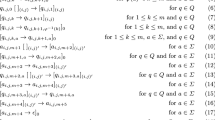Abstract
Many variants of P systems with active membranes are able to solve traditionally intractable problems. Sometimes they also characterize well known complexity classes, depending upon the computational features they use. In this paper we continue the investigation of the importance of (minimal) cooperative rules to increase the computational power of P systems. In particular, we prove that monodirectional shallow chargeless P systems with active membranes and minimal cooperation working in polynomial time precisely characterise \(\mathbf{P }^{\#{\mathbf{P }}}_{\parallel }\), the complexity class of problems solved in polynomial time by deterministic Turing machines with a polynomial number of parallel queries to an oracle for a counting problem.

Similar content being viewed by others
References
Fortnow, L. (1997). Counting complexity. In L. A. Hemaspaandra & A. L. Selman (Eds.), Complexity theory retrospective II (pp. 81–107). New York: Springer.
Ionescu, M., Păun, Gh., Yokomori, T. (2006). Spiking neural P systems. Fundamenta Informaticae 71(2–3), 279–308. https://content.iospress.com/articles/fundamenta-informaticae/fi71-2-3-08.
Leporati, A., Manzoni, L., Mauri, G., Porreca, A.E., Zandron, C. (2014). Simulating elementary active membranes, with an application to the P conjecture. In Gheorghe, M., Rozenberg, G., Sosík, P., Zandron, C. (Eds.). Membrane computing, 15th international conference, CMC 2014. Lecture notes in computer science, vol. 8961, pp. 284–299. Springer. https://doi.org/10.1007/978-3-319-14370-5_18.
Leporati, A., Manzoni, L., Mauri, G., Porreca, A. E., & Zandron, C. (2015). Membrane division, oracles, and the counting hierarchy. Fundamenta Informaticae, 138(1–2), 97–111. https://doi.org/10.3233/FI-2015-1201.
Leporati, A., Manzoni, L., Mauri, G., Porreca, A. E., & Zandron, C. (2016). Monodirectional P systems. Natural Computing, 15(4), 551–564. https://doi.org/10.1007/s11047-016-9565-2.
Leporati, A., Manzoni, L., Mauri, G., Porreca, A. E., & Zandron, C. (2017). Characterising the complexity of tissue P systems with fission rules. Journal of Computer and System Sciences, 90, 115–128. https://doi.org/10.1016/j.jcss.2017.06.008.
Leporati, A., Manzoni, L., Mauri, G., Porreca, A. E., & Zandron, C. (2017). The counting power of P systems with antimatter. Theoretical Computer Science, 701, 161–173. https://doi.org/10.1016/j.tcs.2017.03.045.
Leporati, A., Manzoni, L., Mauri, G., Porreca, A. E., & Zandron, C. (2020). Subroutines in P systems and closure properties of their complexity classes. Theoretical Computer Science, 805, 193–205. https://doi.org/10.1016/j.tcs.2018.06.012.
Martín-Vide, C., Păun, Gh., Pazos, J., & Rodríguez-Patón, A. (2003). Tissue P systems. Theoretical Computer Science, 296(2), 295–326. https://doi.org/10.1016/S0304-3975(02)00659-X.
Murphy, N., & Woods, D. (2011). The computational power of membrane systems under tight uniformity conditions. Natural Computing, 10(1), 613–632. https://doi.org/10.1007/s11047-010-9244-7.
Orellana-Martín, D., Valencia-Cabrera, L., Riscos-Núñez, A., & Pérez-Jiménez, M. J. (2019). Minimal cooperation as a way to achieve the efficiency in cell-like membrane systems. Journal of Membrane Computing, 1(2), 85–92. https://doi.org/10.1007/s41965-018-00004-9.
Orellana-Martín, D., Valencia-Cabrera, L., Riscos-Núñez, A., & Pérez-Jiménez, M. J. (2019). A path to computational efficiency through membrane computing. Theoretical Computer Science, 777, 443–453. https://doi.org/10.1016/j.tcs.2018.12.024.
Papadimitriou, C. H. (1993). Computational complexity. Boston: Addison-Wesley.
Păun, Gh. (2000). Computing with membranes. Journal of Computer and System Sciences, 61(1), 108–143. https://doi.org/10.1006/jcss.1999.1693.
Păun, Gh. (2001). P systems with active membranes: Attacking NP-complete problems. Journal of Automata, Languages and Combinatorics, 6(1), 75–90.
Păun, Gh., & Rozenberg, G. (2002). A guide to membrane computing. Theoretical Computer Science, 287(1), 73–100. https://doi.org/10.1016/S0304-3975(02)00136-6.
Păun, Gh., Rozenberg, G., & Salomaa, A. (Eds.). (2010). The Oxford handbook of membrane computing. Oxford: Oxford University Press.
Păun, Gh. (2002). Membrane computing: An introduction. New York: Springer.
Sosík, P. (2019). P systems attacking hard problems beyond NP: A survey. Journal of Membrane Computing, 1, 198–208. https://doi.org/10.1007/s41965-019-00017-y.
Sosík, P., & Rodríguez-Patón, A. (2007). Membrane computing and complexity theory: A characterization of PSPACE. Journal of Computer and System Sciences, 73(1), 137–152. https://doi.org/10.1016/j.jcss.2006.10.001.
The P systems webpage. http://ppage.psystems.eu/.
Valencia-Cabrera, L., Orellana-Martín, D., Martínez-del-Amor, M. A., Riscos-Núñez, A., & Pérez-Jiménez, M. J. (2016). Polarizationless P systems with active membranes: Computational complexity aspects. Journal of Automata, Languages and Combinatorics, 21(1—-2), 107–123. https://doi.org/10.25596/jalc-2016-107.
Zandron, C., Ferretti, C., & Mauri, G. (2001). Solving NP-complete problems using P systems with active membranes. In Antoniou, I., Calude, C. S., & Dinneen, M. J. (Eds.). Unconventional models of Computation, UMC’2K, proceedings of the second international conference (pp. 289–301). Springer. https://doi.org/10.1007/978-1-4471-0313-4_21.
Acknowledgements
Antonio E. Porreca was funded by his salary of French public servant, affiliated to Aix Marseille Université, Université de Toulon, CNRS, LIS, Marseille, France.
Author information
Authors and Affiliations
Corresponding author
Ethics declarations
Conflict of interest
On behalf of all authors, the corresponding author states that there is no conflict of interest.
Additional information
Publisher's Note
Springer Nature remains neutral with regard to jurisdictional claims in published maps and institutional affiliations.
Rights and permissions
About this article
Cite this article
Leporati, A., Manzoni, L., Mauri, G. et al. Simulating counting oracles with cooperation. J Membr Comput 2, 303–310 (2020). https://doi.org/10.1007/s41965-020-00052-0
Received:
Accepted:
Published:
Issue Date:
DOI: https://doi.org/10.1007/s41965-020-00052-0




